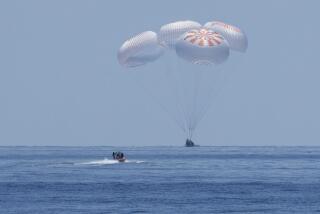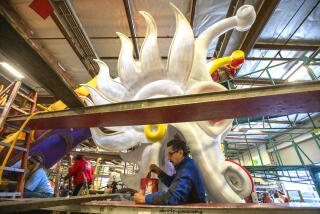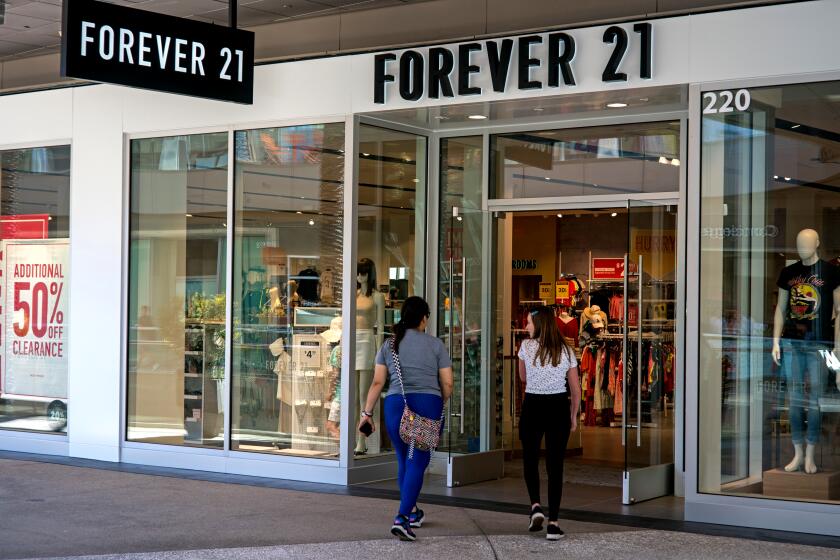Keeping Local Jobs Afloat : Economy: The early morning parade of jet fuselages leaving the bay on barges for Long Beach could be a major factor in keeping 3,500 Convair positions in San Diego.
- Share via
The parade begins and ends in the early morning hours, under the cover of darkness.
Several times each month, a stretch of Harbor Drive and runways at Lindbergh Field are closed to traffic while five massive MD-11 passenger jetliner fuselage sections are trucked from General Dynamics’ Convair Division plant to a barge tied off near the Coast Guard station on San Diego Bay.
When the tides are right, a tug boat captain adeptly pulls the barge away from shore, sending the 147-foot, 45,600-pound fuselage sections on a 12-hour, 110-mile trip up the coast to the Port of Long Beach.
There, the fuselage sections, mounted on specially designed trailers, are maneuvered through the streets of Long Beach--again, during the early morning--to Douglas Aircraft Co.’s assembly plant at Long Beach Municipal Airport.
Few San Diegans have reason to be up and about to watch the early morning parades that Convair has staged during the past two decades. But the unlikely spectacle is important to San Diego’s economic well-being and could be the factor that might keep 3,500 jobs in the city.
The barge represents the cheapest way to ship the fuselages, and with General Dynamics’ operations on the sale block, those lower costs might persuade an eventual buyer to keep the jobs in the area rather than consolidating elsewhere.
Those jobs were jeopardized early this year when General Dynamics said it would sell the MD-11 operation during an ongoing restructuring that will leave the Falls Church, Va.-based company focused on weapons systems and rockets.
That controversial restructuring also casts doubts about the jobs of another 4,500 Convair employees who work on cruise missile programs. Many of the missiles operations jobs could be lost if Hughes Aircraft Co., which is buying Convair’s missiles business, consolidates operations in Tucson.
Civic leaders are more optimistic, however, that the MD-11 operation’s eventual buyer will leave the complex fuselage manufacturing and assembly business in San Diego.
Their optimism is based largely on the longstanding relationship between Convair, which has served as the sole producer for nearly three decades of fuselage sections used to build Douglas’ KC-10, DC-10 and MD-11 aircraft.
A buyer that intends to consolidate the capital- and labor-intensive MD-11 line elsewhere would have to achieve “tremendous cost savings . . . before there could be any out-of-town consolidation,” according to Dan Pegg, president of the San Diego Economic Development Corp.
That’s because the 2.8-million square-foot Lindbergh Field plant is filled with massive--and unique--machine tools and dies that are used to bend and bash the high-quality aluminum used to manufacture and assemble MD-11 jetliners.
General Dynamics officials have said that the Lindbergh Field plant’s proximity to Long Beach has “significant value” because finished fuselages can be trucked to the nearby barge landing for the relatively quick trip to Long Beach, Pegg said.
While there are northbound railroad tracks near Convair’s plant, oceangoing barges “are the least costly of any option,” said Karl A. Wheeler, an MD-11 program manager at General Dynamics. “It really works out well.”
Even before General Dynamics announced its restructuring, the MD-11 program was in flux.
General Dynamics has the sole contract to produce 200 of the fuselage sections for Douglas. But in January, Douglas stretched out the delivery schedule, so instead of building 50 fuselages during 1992, Convair will build about 40.
And, during 1991, General Dynamics failed to generate a profit from the MD-11 line, largely because Convair fell behind on production and was forced to hire additional workers--and pay considerable overtime.
The company anticipates a return to profitability during 1992, General Dynamics spokeswoman Julie Andrews said.
While the fuselages typically move northward like clockwork, the routine is occasionally slowed or interrupted.
Bad weather has forced tugboat crews to remain in San Diego Bay. And, during the Los Angeles riots, crews were forced to delay the shipment. When conditions improved, the MD-11 fuselages once again moved through Long Beach--under the watchful eyes of National Guard troops.
Yet, even with the seemingly endless list of potential problems--running the gamut from tight deadlines, a complicated regulatory permitting process, stormy weather and human error--it usually takes less than 24 hours for the fuselages to move from Lindbergh Field to Douglas’ Lakewood plant.
One of those trips ended at 3:55 a.m. on a recent day, when Convair’s 79th MD-11 fuselage assembly came to rest outside a massive hangar at the Douglas plant, and a Douglas supervisor signed receipts for the massive aluminum cylinders. Later this year, Douglas will turn the 79th MD-11 over to a New York-based finance company, which will in turn lease it to one of the world’s commercial airlines.
Two days before, in the late afternoon, Convair employees were putting the finishing touches on the 79th fuselage assembly. By 4 p.m., Convair crews had wrapped tarps around four of the five large, aluminum cylinders that range from 8.3 feet to 55.8 feet in length.
But the fifth and largest segment wouldn’t be ready for wrapping until Douglas officials signed off on a quality inspection form. “Each airline (customer) has little peculiarities that only that airline wants,” Wheeler said. “They’re only ready (for shipping) when Douglas signs off.”
Paperwork completed, Convair employees used a large, overhead crane in the Lindbergh Field plant to drape the last fuselage sections with a specially designed tarp that weighs 1,200 pounds.
The 79th fuselage began its northward journey shortly before 4 a.m. June 4, when Convair manager Hank Massey,walkie-talkie in hand, urged crew members to “go ahead and roll ‘em.” Within minutes, the five assemblies, loaded on four trailers, began their ghostly procession across the closed taxiways.
As is the case throughout the journey, time was at a premium because “you don’t want to be out there when the airport opens,” Massey said.
A few minutes later, the assemblies had crossed Harbor Drive to a staging area near a dock at General Dynamics’ bay-front hangar.
When Mother Nature cooperates, the early morning procession coincides with the arrival of high tide--which gives the barge and tugboat enough water to approach General Dynamics’ dock. But on June 4, the fuselages remained on shore until shortly before 11 a.m. when the tide rose.
Convair employee Karl Shermon used an airport-style tractor to push the massive trailers onto the barge--no mean feat since Shermon’s line of sight was totally blocked by the massive fuselages.
Pointing to two Convair employees on either side of a fuselage section, Shermon said that “these two guys are your eyes. . . . The main thing is to take it slow . . . to keep it between (yellow) lines.”
When the trailers were in position, crews from Long Beach-based Foss Maritime tied the fuselages in place. Then, tugboat Captain Andy Anderson used the shallow-draft tug Palomar to pull the massive barge away from Convair’s bay-front facility, a delicate task given the shifting wind, moving tide and the small flotilla of pleasure boats moored near General Dynamics’ hangar.
In less than a half hour, the Palomar pushed and pulled the barge into deeper water, where, in a delicate operation, the barge was hooked to a towline on the Pacific Titan, one of Foss’ larger, oceangoing tugs.
Shortly before 1 p.m., Captain Bob Birdsellsteered the Titan past Ballast Point, set a course for Long Beach and turned the tug over to ship’s mate Steve Bobal.
Throughout his six-hour shift, Bobal used binoculars, radar and the ship’s radio to keep close tabs on oceangoing traffic and navigational buoys. Constant monitoring is the order of the day for tugboats because maneuvering takes time with a barge in tow.
Just north of La Jolla, however, traffic thinned out noticeably and the frenzied pace of the harbor gradually gave way to what Birdsell called “tugboat time.”
For the Titan’s crew, that meant constantly monitoring the radio and radar, and making adjustments to the 2-inch-thick towline that links the tug and barge. Crew members regularly looked back to make sure the barge and the all-important towline were secure.
But with the exception of a handful of ships, the Titan was largely alone on the ocean.
At sea, the Titan’s four-man crew divides each trip into a succession of six-hour shifts. Shortly after leaving San Diego, Birdsell and engineer Steve Thrupp retired to their cabins to sleep until 6 p.m. With Bobal in the wheelhouse, deckhand Nick Viazevich prepared a meal that included a fresh-tossed salad, corn on the cob, steak and sausage and ice cream bars.
As night fell, Birdsell used the radio to contact an oceangoing tug that was headed to the East Coast through the Panama Canal. While the weekly runs to San Diego are welcome, Birdsell’s eyes lit up at the prospect of an East Coast trip lasting for three months.
The statewide economic slowdown that has plunged San Diego into a recession also has cut back demand for tugboat services. The industry is in the midst of a consolidation, with many smaller companies disappearing, Bobal said.
The Palomar continued on course until shortly before 11 p.m. Thursday, when the tug’s radio brought word of a potential snag: The Titan wouldn’t be allowed to enter the Long Beach Ship Channel until after the oil tanker Umm Said departed at 12:30 a.m. Friday.
Birdsell throttled back on the Titan’s massive twin diesel engines, and Thrupp manipulated the tug’s powerful electric winch to reel in the barge. As winds and tide pushed the tug and barge in circles, the Long Beach skyline glistened in the distance.
At 12:30, another snag developed: The Umm Said was slowly making its way out of Long Beach, but port officials directed the Titan to remain out of the shipping channel until after the inbound tanker Exxon Jamestown cleared Pier D, where the fuselages were to be unloaded.
Time, a plentiful commodity earlier in the day, was running short because the fuselages were scheduled to begin the final land leg of their journey at precisely 3 a.m.
Shortly before 2 a.m., the Titan slid in line behind the Jamestown, and Birdsell began the deft maneuvering required to keep the barge pinned against Pier D. In less than 10 minutes, drivers had moved the four trailers to a nearby staging area and the Titan moved up the channel to a nearby dock.
Despite the delays, crew members were confident that the last leg of the trip would go smoothly.
“We’ve gotten it pretty well down to the point that we feel comfortable,” said Bill Milligan, traffic manager for Long Beach-based Heavy Transport, which handles the final leg of the journey from the Port of Long Beach to the Douglas plant.
Just minutes after 3 a.m., the convoy of four trucks and 11 escort vehicles left the port and began the slow journey through the deserted streets of Long Beach.
The convoy traveled an 11-mile route that is carefully designed to avoid low-hanging tree branches, overhead traffic signals and sharp turns.
The convoy drew understandably quizzical stares from the handful of motorists and pedestrians along the way. Milligan somberly pointed out a handful of buildings that were burned out in the recent rioting.
At each intersection, escort vehicles with lights flashing stopped cross traffic. City crews pushed five traffic signals out of the way--at a cost of $285 per signal per trip. Heavy Transport last year paid nearly $7,000 to modify the original signal systems that were fixed in place.
Shortly before 4 a.m., security guards at Long Beach Municipal Airport unlocked a gate, and the first truck crossed over a series of taxiways that ring Douglas’ massive Long Beach facility.
Within minutes, the trailers were parked in a line and a Douglas official had signed a delivery receipt. “This is where we land them,” Milligan said. “Now I go home, get changed and get ready for another day at the office.”
MD-11
The MD-11 fuselage assemblies have five parts, which are joined together at the Douglas Aircraft Co. Lakewood plant. The C/D section, holding the first-class seats, sits just behind the nose cone, which is manufactured separately by Douglas. The E and F/G sections contain the business class and tourist seating sections. The E and F/G sections are joined by the 5 and 6 sections, which are referred to as “plugs.”
C/D 6 E 5 F/G Total Length (ft.) 55.8 8.3 33.5 10.3 38.9 146.8 Weight (lb.) 17,379 2,313 10,488 3,151 12,276 45,607
More to Read
Inside the business of entertainment
The Wide Shot brings you news, analysis and insights on everything from streaming wars to production — and what it all means for the future.
You may occasionally receive promotional content from the Los Angeles Times.










